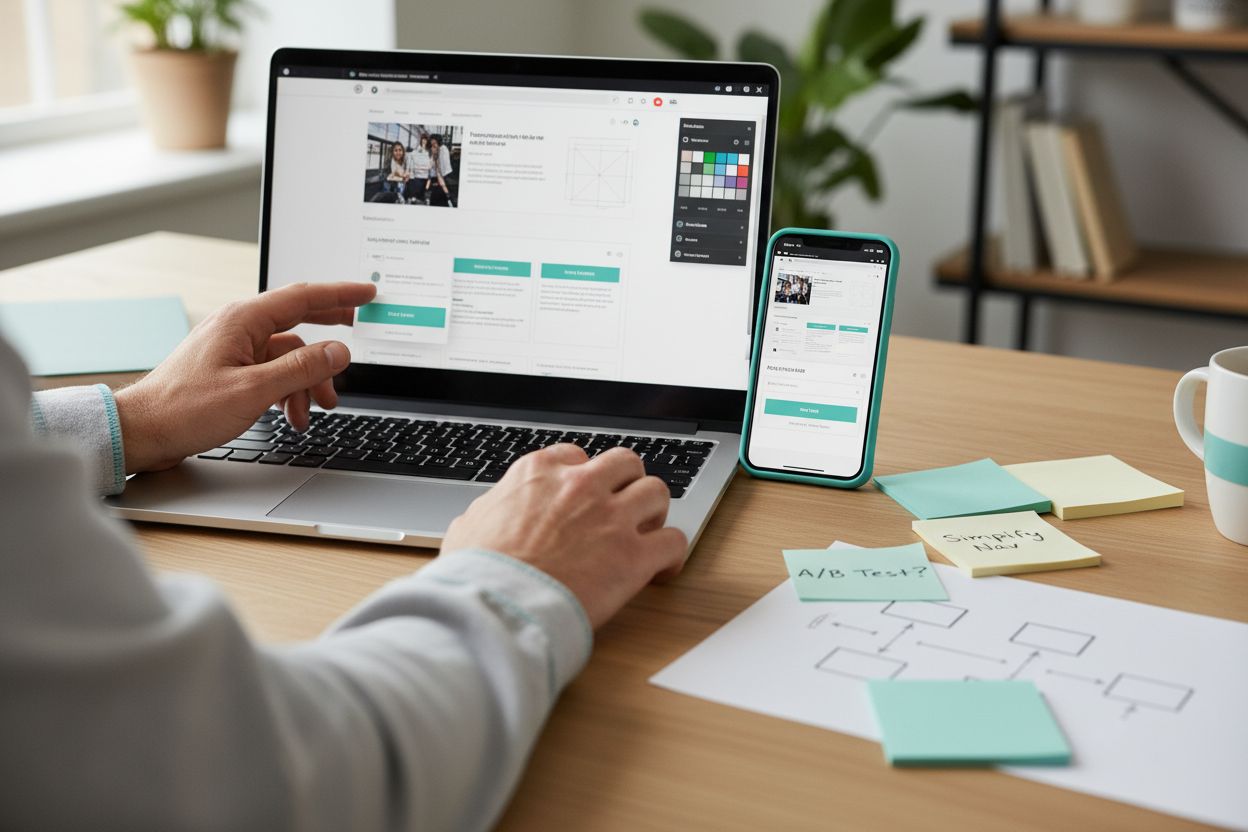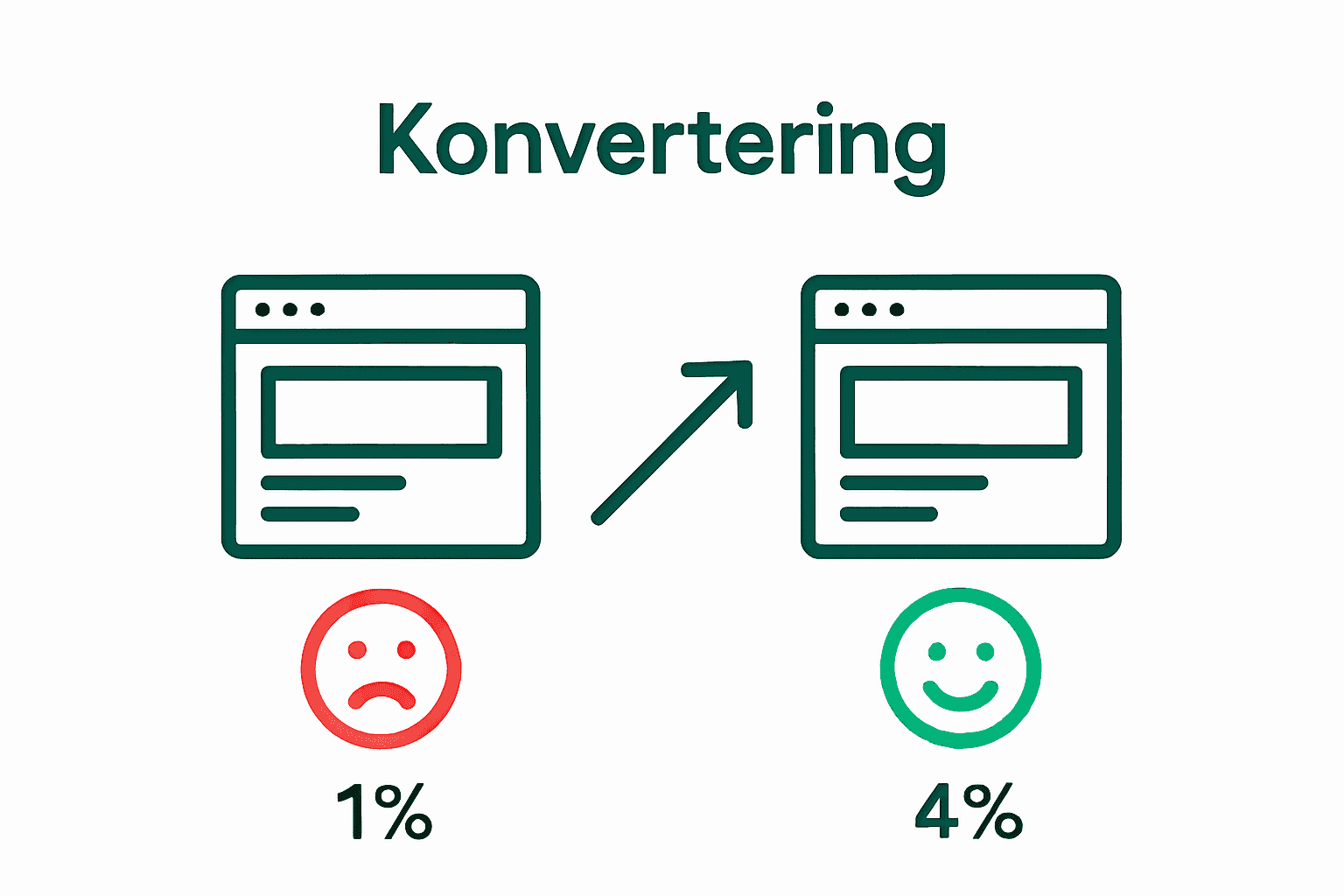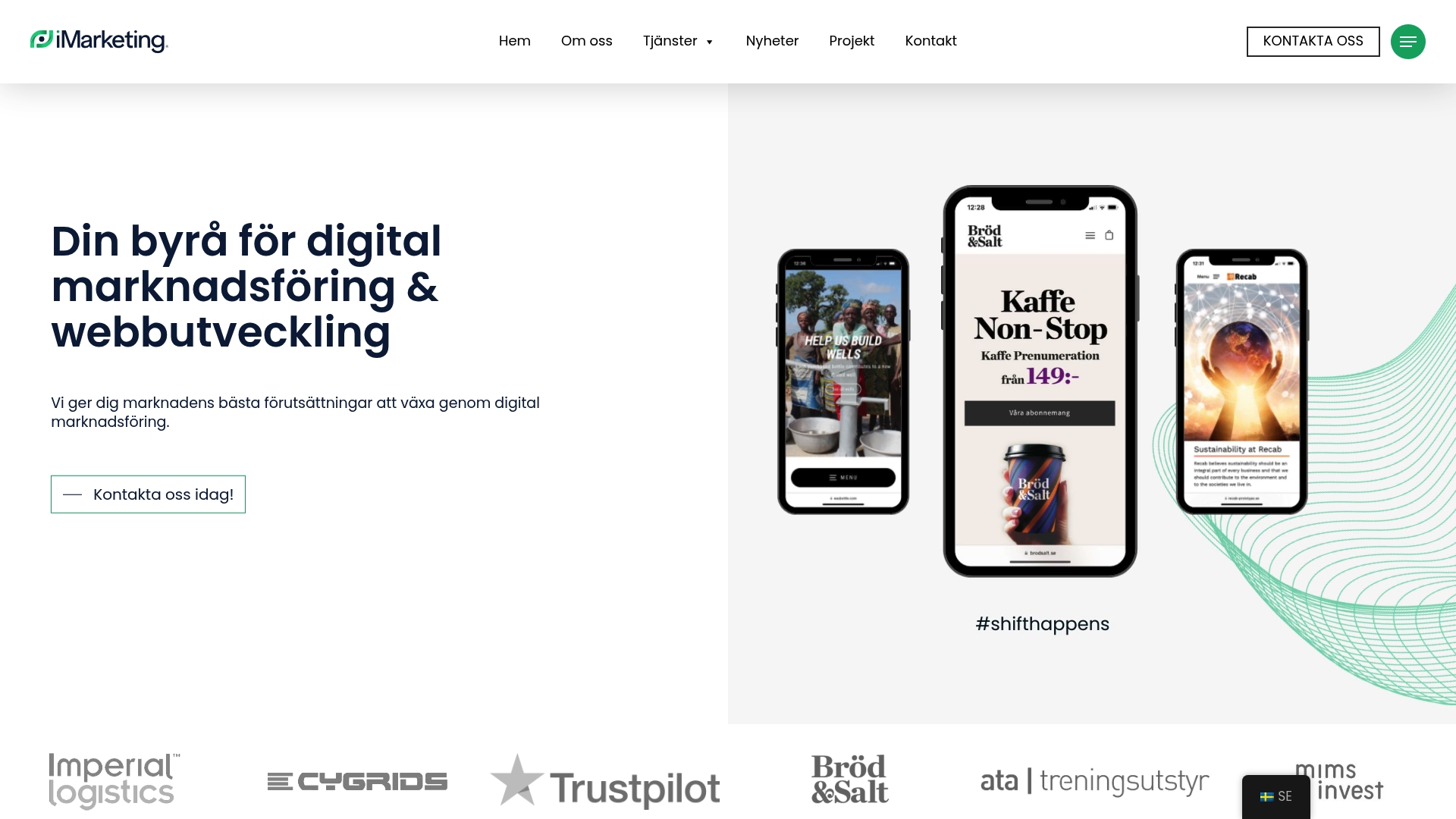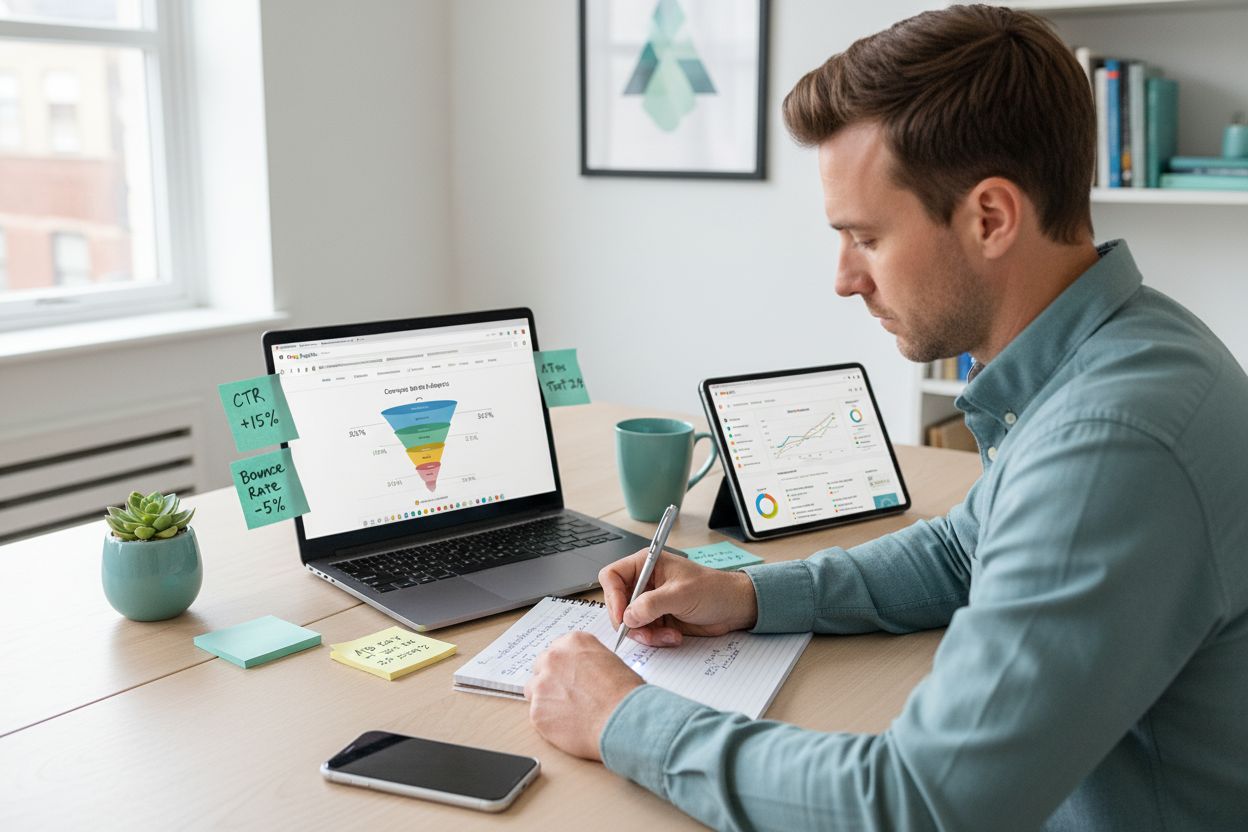You want to increase conversions and get more customers through your website. Statistics show that small changes can increase conversion rates by up to 20 percent instantly. Yet most people only focus on fancy design and new ads. The real difference is made when you start digging into your own data and understand what visitors are actually doing – and why they’re leaving. Suddenly, a few clicks can be worth thousands of dollars, if you just know where to look.
Table of contents
- Step 1: Analyze your current conversion data
- Step 2: Define the needs and behaviors of the target group
- Step 3: Optimize your website for usability
- Step 4: Create compelling content and offers
- Step 5: Implement A/B testing to measure effectiveness
- Step 6: Evaluate results and adjust strategy
Quick summary
| Key point | Explanation |
|---|---|
| 1. Analyze conversion data carefully | Collect and review data to understand visitor behaviors and identify areas for improvement. |
| 2. Create detailed customer personas | Use interviews and surveys to map customer needs and behavioral patterns. |
| 3. Optimize website usability | Ensure that navigation is intuitive and that visitors can easily find relevant information. |
| 4. Develop compelling and relevant content | Create content that addresses customer needs and calls to action. |
| 5. Implement A/B testing continuously | Run tests to measure the impact of different elements on conversions and adjust the strategy based on the results. |
Step 1: Analyze your current conversion data
When you want to improve your conversions, the journey starts with a thorough analysis of your existing data. This step is about creating a clear current picture that gives you insights into how your digital channels and websites are actually performing.
Start by collecting data from all your digital platforms. Google Analytics is a powerful tool that gives you detailed insights into visitor behavior, conversion rates, and traffic flows. Focus especially on key metrics like conversion rate, bounce rate and average session timeThese numbers tell more than just numbers – they reveal the story of how potential customers interact with you online.
Our guide to data analysis can help you interpret these results more effectively. Look specifically at which pages have the highest and lowest conversion rates. Identify patterns: Which pages keep visitors coming back? Which ones make them leave? Every detail counts.
When analyzing your data, pay attention to:
- Conversion rate for different traffic channels
- Behavior on different devices (mobile vs desktop)
- Specific pages with high and low conversion rates
It’s not enough to just collect data – you need to understand the story behind the numbers. A low conversion rate can be due to several factors: a complicated purchase process, unclear calls-to-action, uninteresting content or technical issues on the website. Every detail gives you a clue as to where the potential for improvement lies.
Finally, document your current results. Create a reference document where you note all your key metrics, which will serve as your starting point for future comparisons. This document will be your compass as you begin your journey towards improved conversions.
Step 2: Define the needs and behaviors of the target group
After analyzing your current conversion data, the next critical step is to gain a deeper understanding of your specific target audience. This is not just about demographic information, but about creating a thorough understanding of their real needs, pain points, and behavior patterns.
Begin the process by developing detailed customer personasThese are not just general profiles but living representations of your potential customers. Interviews, surveys and social media analysis will become your most important tools. Our guide to copywriting can help you formulate the right questions that truly reveal your customers' underlying motivations.
Focus on understanding purchasing behaviors and decision-making processes. What triggers make them interested? What obstacles stop them from converting? Map the entire customer journey from first touchpoint to final conversion.
Important aspects to investigate:
- Demographic details (age, occupation, income)
- Specific problems they want to solve
- Communication channels they prefer
- Their digital behavior patterns
Use tools like Google Analytics and Facebook Audience Insights to gather objective data. Supplement these quantitative insights with qualitative methods such as in-depth interviews and focus groups. The goal is to create a 360-degree understanding of your target audience.
To help you understand and compare the most important aspects of your audience analysis, see this table of analysis factors and the tools/methods mentioned.
| Analysis factor | Method/Tools | Purpose |
|---|---|---|
| Demographic details | Surveys, interviews | Mapping the background of the target group |
| Problems and needs | In-depth interviews, social media analysis | Identify customer challenges |
| Communication channels | Social media analysis, surveys | Choosing the best channels for communication |
| Digital behavioral patterns | Google Analytics, Facebook Audience Insights | Understand where and how the target audience acts |
| Decision process and purchasing behavior | Focus groups, surveys | Reveal barriers and triggers to conversion |
| Compilation of customer personas | Documentation | Create a foundation for strategy and content |
Finally, you should summarize your insights in a document that clearly describes customer personas and their specific needs. This document will become your strategic guide to tailoring content, communications, and conversion strategies that directly resonate with your audience.
Step 3: Optimize your website for usability
Usability is key to successful conversions. A website that is difficult to navigate and understand will scare away potential customers faster than you can say “conversion optimization.” The goal is to create a seamless, intuitive experience that makes visitors want to stay and take action..
Our optimization guide emphasizes the importance of a clean and clear design. Start by reviewing your website from a visitor's perspective. Is the information easy to find? Does it take too many clicks to reach important pages? Simplicity and clarity are crucial.
Focus on responsive design that works perfectly on all devices. Given that the majority of web traffic now comes from mobile devices, your website needs to look just as good on a smartphone as it does on a desktop computer. Use tools like Google’s Mobile-Friendly Test to ensure optimal performance.
Important aspects to optimize:
- Charging time (under 3 seconds)
- Clear and visible call-to-action buttons
- Simple and intuitive navigation menu
- Consistent and appealing design
Usability principles shows that a well-structured website can significantly increase conversion rates. Work with clear typography, contrasting colors and airy layoutEvery element on the page should have a clear purpose and guide the visitor towards conversion.

Finish by conducting usability testing. Ask colleagues, friends, or even customers to navigate your site and provide honest feedback. Their perspective can reveal hidden usability issues that you don't see. Document their experiences and use the insights for continuous improvement.
Step 4: Create compelling content and offers
Content is the heart of conversion. It’s no longer enough to just produce content – you have to create compelling stories that directly address your customers' needs and pain pointsEvery line of text, image, and headline should work hard to build trust and drive action.
Our guide to audience engagement emphasizes the importance of authentic and value-oriented content. Start by mapping out what specific problems your offerings solve.. Formulate your message so that it feels personal and directly targeted to your specific target group.
Your value proposition must be crystal clear. According to expert analysis You only have a few seconds to grab a visitor's attention. Use language that is:
- Concrete and specified
- Focused on results
- Free from technical jargon
- Emotionally engaging
Used social proof that reinforce your offering. Customer stories, reviews, and case studies build credibility faster than any marketing copy. Show real results and let your current customers tell the story.
Be strategic with your call to action. They should be clear, direct and encourage immediate action. Experiment with wording, colors and placement. A small adjustment can make a big difference in conversion rates. Don’t forget to create a sense of urgency – limited offers, time-limited discounts or exclusive bonuses can be crucial in getting the visitor to act now.
Step 5: Implement A/B testing to measure effectiveness
A/B testing is the scientific method for improving your conversions. It's not about guessing, it's about precise, measurable experiments that reveals exactly what works for your specific audience. Think of it as a digital research method where every detail can be the key to increased success.
Our ROI Statistics Guide emphasizes the importance of data-driven decisions. Start by choosing a specific variable to test – it could be anything from a button color to a headline wording. Tools like Google Optimize or Optimizely are perfect for these experiments.
According to usability research It is crucial that the tests are set up correctly. Create two versions (A and B) that differ in only one detail. This ensures that the results are unambiguous and reliable.
Important points to test:
-Call-to-action wording
- Image selection and placement
- Pricing
- Heading texts
- Form layout
Statistical significance is key. Let the test run until you have enough visitors for the results to be meaningful. This usually means between 1000-5000 visitors per variation, depending on your conversion rate.
Document thoroughly. Create a test archive where you save each experiment’s details, hypotheses, results, and lessons learned. This will become your knowledge base for future optimizations. Remember – A/B testing is an ongoing process. Each test gives you insights that help you understand your audience better and gradually improve your conversions.
Step 6: Evaluate results and adjust strategy
Performance analysis is where the real improvement journey begins. Success is not a final destination but a continuous process of developmentAfter completing your previous steps, it is crucial to systematically review and interpret the collected data to make intelligent, data-driven adjustments.
Our guide to digital sales tools emphasizes the importance of ongoing evaluation. Start by compiling all the key metrics from your previous A/B tests, website analytics, and conversion metrics. Create a dashboard that gives you a holistic view of your digital performance.
Focus on three critical perspectives:
- Quantitative results (figures and statistics)
- Qualitative insights (user behaviors)
- Overall business goals
Evaluate each metric with a critical eye. A small improvement in conversion rate can translate into significant revenue increases.
 Pay attention to patterns: Which changes had the most positive effect? Where is there still potential for development?
Pay attention to patterns: Which changes had the most positive effect? Where is there still potential for development?
Document every insight methodically. Create a living document where you continuously update lessons learned, hypotheses, and experiments conducted. This will become your strategic compass for future optimizations. Don’t forget to be flexible – the digital landscape is changing rapidly, and your strategy must be able to adapt accordingly.
End each evaluation period with a concrete action plan. What three specific improvements can you implement based on your latest results? Set realistic goals, follow up on them systematically, and be prepared to quickly adjust your approach as new insights emerge.
Take your next step towards higher conversion with expert help
Have you ever felt unsure after analyzing your numbers and trying to understand why visitors are leaving instead of buying? Interpreting data and turning insights into tangible results is challenging, especially when every little detail on your website affects conversion rates. We at iMarketing.se has helped hundreds of Swedish companies overcome these obstacles and create websites that lead to more customers and better business.

Want to see what optimized web development and clear digital strategies can do for your business? Explore our latest success stories and let us show you the way from analysis to turnkey solutions. Visit iMarketing.se and book a meeting today. Take the opportunity to take control of your digital growth and start increasing your conversions now.
Frequently asked questions
How do I analyze my current conversion data?
Start by collecting data from all digital platforms, such as Google Analytics. Focus on key metrics like conversion rate, bounce rate, and average session duration to understand how visitors interact with your website.
What are customer personas and how do I create them?
Customer personas are detailed profiles of your potential customers that help you understand their needs and behaviors. Develop them through interviews, surveys, and social media analysis to create a holistic picture of your target audience.
How can I optimize my website for user-friendliness?
Focus on a clean and clear design, responsive layout, and reducing load times. Make sure navigation is intuitive and important pages are easily accessible to improve the user experience.
What is A/B testing and how does it work?
A/B testing involves comparing two versions of a website or landing page to see which performs better. Test a specific variable, like a headline or call-to-action, to gather data on what works best for your audience.


